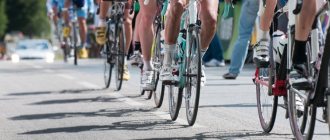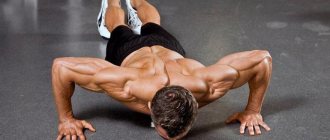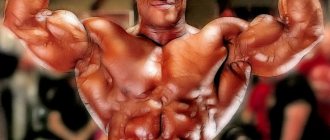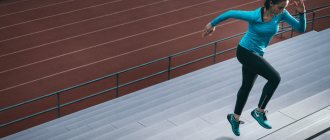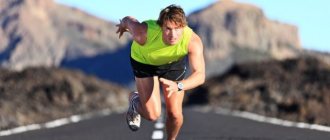Dmitry Kalashnikov
President of the Fitness Professionals Association (FPA)
Founder of the Banana Gym club, head of the Training and Consulting Centers and the FPA School of Management, partner of the International Festival of Healthy Lifestyle and Sports SN PRO EXPO FORUM and expert of the “Championship”.
“How to pump fat into muscles”, “muscles sag and turn into fat” - have you heard this? Is it possible? If not, why not? Let's figure it out together.
How realistic is it to “sweat” kilos?
What is the difference between fat and muscle
To dot all the i's forever, think about the fact that muscle and fat are two different substances, with a different set of chemical and physical properties.
In anatomy, there are four main types of tissues:
- Muscular
- Connective
- Nervous
- Epithelial
Fat is a connective type, as are ligaments, tendons, bones and blood.
There are three types of muscle tissue:
- Smooth
- Heart
- Cross-striped
In bodybuilding, it is the striated muscles that are trained. Another name for them is skeletal.
Different types of tissues simply physiologically cannot transition or “transform” (call it whatever you want) from one to another.
Therefore, to the question of whether it is possible to turn fat into muscle, the answer is no. Remember this and don't believe people who say otherwise. Their knowledge of the human body leaves much to be desired.
How many calories to eat: foods
It is important to consider the calorie content of food by paying attention to how many calories you expend. Nutrition should be 10-15% higher than the calories consumed by your body.
List of high protein foods:
- chicken breast - 120 g of boiled breast without skin - 35.5 g of protein, and so that the food does not seem monotonous, look for recipes for salads and bowls, so you will eat tasty, varied and not bland,
- turkey - in the drumstick - about 27 g of protein and almost no fat, as in chicken breast,
- eggs - 6.28 g of protein, as well as choline, healthy fats, vitamins,
- salmon steak - 227 g - 58.5 g of protein, as well as omega-3 fatty acids,
- tuna - 28 g contains 7 g of protein and the same omega-3 fatty acids, the benefits of which need not be talked about, since everyone understands this.
What else should be included in the diet of both men and women if they need to gain muscle mass:
- cottage cheese,
- milk,
- jerky,
- beans,
- lean beef,
- seafood,
- quinoa,
- Champignon,
- White mushrooms,
- Brown rice,
- lentils,
- buckwheat,
- oatmeal,
- chickpeas,
- peanut,
- walnuts,
- almond,
- soy milk,
- tofu cheese,
- cheddar cheeses, mozzarella,
- sunflower seeds, pumpkin seeds.
High Protein Foods
About the emergence of the myth
But from somewhere this opinion appeared among people far from physical education and sports. And they definitely skipped biology and human anatomy classes at school.
The myth of the transformation of fat into muscle arose from ordinary visual observations of overweight people.
Such a person comes to the gym and starts working with hardware. At the same time, he goes on a diet and does cardio.
If everything is done correctly, then after several months of continuous effort, a metamorphosis of the body occurs - there is less and less fat, which makes the muscles more visible.
To an outside observer, it seems that a fat person has done everything at the same time. After all, if before the relief was not visible, now it has become noticeable. That is why some argue that in this case the muscles were “distilled” into fat. But in reality something else happened.
What if you want to remove fat in specific areas?
Separately, it is worth mentioning how to remove fat from specific places. The answer is the same - no way. It doesn’t matter which muscles are working: the stomach, legs or hips. When they need energy, including fat, the endocrine system gives a signal to the fatty tissues. It releases the corresponding hormones - adrenaline, norepinephrine, cortisol. Once they enter the tissue, they instruct the fat cells to give up some of the fat to nourish the muscles.
Photo: unsplash.com/@eugenechystiakov
Hormones are in the blood. Blood is in vessels, capillaries. Capillaries are everywhere. That is, the signal is sent to all adipose tissue at once, to where the capillaries are. In this sense, all subcutaneous adipose tissue is like a single gas tank. Somewhere fat will be broken down faster (face, arms, shoulders), somewhere - slower (buttocks, stomach, thighs). Fat on the sides and thighs of a person, like the humps of a camel, are strategic reserves. This happened in the process of evolution, nothing can be done about it.
Conclusion: eat right, exercise right, get enough sleep, control stress and give up bad habits! Then you can come to any desired shape.
How to lose weight and get fit at the same time
In fact, it is almost impossible to effectively burn fat and increase muscle volume at the same time. True, there is one exception, but more on that later.
The fact is that growing muscle mass and burning fat are two mutually exclusive processes.
There are two balanced phenomena in the body - anabolism (tissue synthesis) and catabolism (tissue breakdown). Anabolism predominates during the day, catabolic processes predominate at night. As a result, body weight remains stable.
When you strive to increase muscle size and do everything right, an environment is created where anabolism predominates. First of all, muscles grow, but the synthesis of adipose tissue also increases. This is an inevitable “side effect” of working on mass.
Excess fat is fought with the help of a cycle of training for relief (drying), which follows after mass-gain.
During this period, conditions are specially created with a predominance of catabolic processes. The fat burning process starts. But at the same time, a certain amount of muscle is burned, which is also inevitable.
A person who is bulky needs an excess of calories, while a person who is lean needs a shortage.
Losing weight and building muscle at the same time is physiologically impossible, at least for this reason.
Now about overweight people who want to reduce body weight.
If you work out in the gym, do cardio regularly and follow a calorie deficit diet, the thickness of the fat layer decreases and the muscles become visible.
In addition, by training with weights, the muscles become more “full” and acquire tone. Without going into details, we will say that this is due to their greater filling with glycogen (a form of energy storage) after the start of regular physical activity.
But there is a belief among competitive bodybuilders that it is possible to gain “lean” muscle mass. It is based on the experience of some professional athletes demonstrating this phenomenon.
True, such bodybuilders in the entire history of bodybuilding can be counted on the fingers of one hand.
They themselves don’t know their secret, because they shared in detail all the features of pre-competition preparation, which many tried to repeat. But no one was able to achieve such a result.
There are most likely two explanations:
- Unique genetics
Natural metabolism that is different from 99% of people. Thanks to him, such bodybuilders become sports stars.
- Mandatory use of steroids, which further alter metabolism
Anabolic steroids are exactly that “magic wand” that helps to work a miracle and simultaneously burn fat and build muscle mass. But again, a small number of professionals.
As for the majority, almost all competitive bodybuilders use steroids during the cutting period. This helps them lose weight even better and not lose critical amounts of muscle. This demonstrates the anti-catabolic properties of hormonal steroid drugs.
Batch approach
Bodybuilders are familiar with the periodic approach: it aims to convert fat into muscle tissue. Each period lasts from 4 to 6 weeks. At the first stage, fat burning occurs, which requires:
- cardio loads,
- a diet that uses additional energy from your body’s fat tissue.
At the next stage you need to gain muscle mass, for this:
- nutrition with calorie counting,
- intense power loads,
- sports supplements,
- training strictly according to schedule,
- compulsory rest as planned.
Muscle growth and weight loss - the principle of periodization
Bodybuilding specialists have long solved the problem of anabolism-catabolism.
If you can’t run both processes at the same time, then you need to manage them one by one.
As an example, use the following periodization scheme:
- Work for mass - 2-3 months
- Drying - 1.5-2 months
- Short holiday - a week
- Repeating the entire cycle again
The point of alternating such varied workouts is to increase muscle volume during the mass-gaining period and burn the excess fat that you gained along with them during the cutting period.
At the same time, it is necessary to constantly achieve the growth of new muscle mass from one mass-gaining cycle to another, each time reducing the percentage of fat more. If you do everything right, you will make constant progress.
What should I do?
Thus, if you are not a beginner with a high percentage of body fat, not a person who once worked out, not a muscle-building chemist, most likely, it will not be possible to grow muscles and lose weight at the same time, unless you are a genetically gifted person. Therefore there are two options.
The Classic Approach: Gaining and Cutting Cycles
The most effective option is to choose one goal and work on it. This is why professional bodybuilders use muscle building, fat burning and cutting cycles. They can vary in duration - from several weeks to several months. Divided into phases, these processes are much more efficient.
Basic rules for simultaneously losing weight and gaining muscle mass
But it is worth remembering five main rules:
- You need to include a lot of protein in your daily diet and reduce your fat intake. The body will accept an increase in protein elements, a decrease in fats and carbohydrates as a decrease in calories. Thus, the process of losing weight and gaining muscle mass will begin.
- Full rest is recommended. Eight hours of sleep is good for replenishing energy.
- Workouts must be divided by days: days 1 and 3 – strength training, days 2 and 4 – cardio, interval exercises. It turns out that the first day will work on muscle mass, and the second on weight loss.
- Drink plenty of water, at least 2 liters per day. Water will help you lose weight, develop definition on your legs, maintain body balance, avoid cellulite, and smooth out lumpy fat deposits. Along with strength and cardio exercises, trainers drink plenty of water, at least 2 liters per day. Water will help you lose weight, develop definition on your legs, maintain body balance, avoid cellulite, and smooth out lumpy fat deposits. Along with strength and cardio exercises, trainers recommend combining massage. Anti-cellulite, classic accelerates blood through the veins, accelerates the body's metabolic processes.
- Remember, a grueling diet will not allow you to lose weight quickly; all the lost kilograms will come back again. To grow muscles and lose weight, perform basic exercises for all muscle groups, take a break from strength training and consult with a trainer about the effectiveness of your actions, use different types of exercises, and do not forget about warming up before training. Give preference to barbell presses, deadlifts, dumbbells, and cardio equipment.
Meal 1
French toast
- 2 pcs.
- 128.4 Kcal
- 4.5 proteins, g
- 3.7 fat, g
- 19.2 carbohydrates, g
Omelette
- 1 whole egg, 10 egg whites and spices to taste
- 235.5 Kcal
- 16.1 proteins, g
- 18 fats, gr
- 1.1 carbohydrates, g
Meal 1
- 363.9 Kcal
- 20.6 proteins, g
- 21.7 fat, g
- 20.3 carbohydrates, g
What happens during weight loss?
Weight loss is most often a combination of loss of fat, muscle, and glycogen stores (water weight). Ideally, most weight loss should come from burning fat (,).
To lose weight, you must achieve a calorie deficit by eating fewer calories than your body needs daily, increasing physical activity to burn calories, or a combination of both.
However, too much of a calorie deficit can lead to rapid muscle loss as the body breaks down muscle to use it as an emergency energy source. Therefore, a moderate deficit of about 500 calories, or 10–20% of your total daily calorie needs (, , ) is recommended.
During a moderate calorie deficit, fat is used as an energy source to maintain normal body functions.
Triglycerides stored in fat cells are broken down and sent to the mitochondria to produce adenosine triphosphate (ATP), which is the body's main source of energy (,).
This process, known as beta-oxidation, produces carbon dioxide and water as byproducts. Both are exhaled during breathing and excreted in urine and sweat.
Thus, when fat is burned, it is not converted into muscle, but rather converted into usable energy (,).
To maintain muscle mass while losing weight, it is recommended to do strength training at least 2-3 times a week. In addition, a protein-rich diet has been shown to reduce muscle loss during a calorie deficit (, ).
Conclusion:
During weight loss, fat is converted into useful energy and byproducts. To maintain muscle mass, it is important to maintain a moderate calorie deficit, eat plenty of protein, and exercise several times a week.



